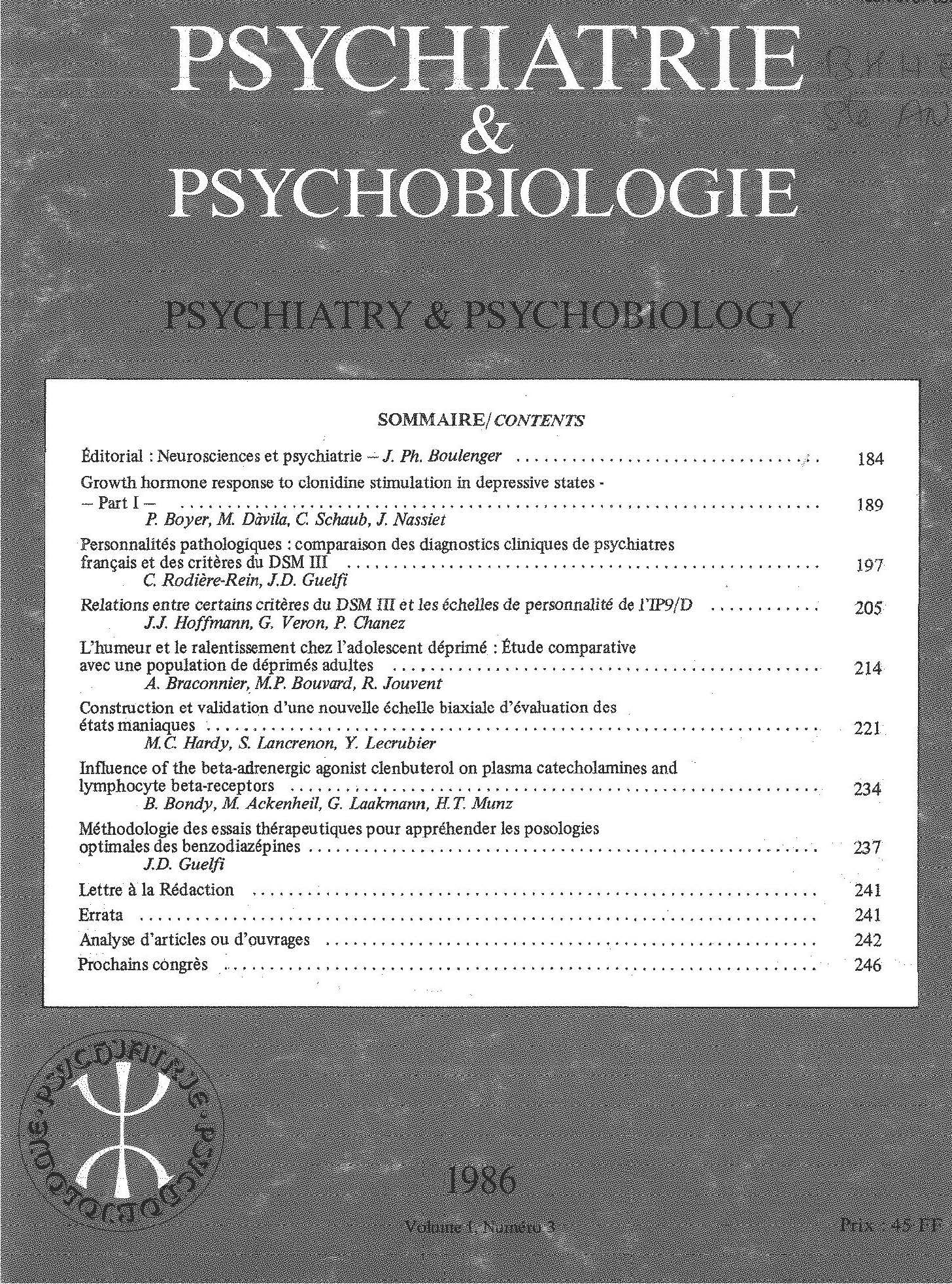Article contents
Intérêt des études polygraphiques de sommeil dans le suivi des traitements antidépresseurs. Application à la trazodone
Published online by Cambridge University Press: 28 April 2020
Résumé
L’analyse des tracés polygraphiques de sommeil permet d’isoler certains paramètres spécifiques des états dépressifs et de suivre leur évolution sous traitement. Dans cette étude sont rapportés les effets de la trazodone sur les enregistrements de sommeil, en début et en fin de traitement, chez 10 sujets déprimés. La trazodone a été prescrite à la posologie de 400 à 600 mg par jour pendant 5 semaines. Les enregistrements de 3 nuits consécutives avant traitement ont été utilisés comme témoin.
L’amélioration clinique sous traitement a été jugée sur la réduction de plus de 60% des scores à l’échelle MADRS (Montgomery and Asberg Depression Rating Seule). Au début du traitement, un effet hypnotic-like (augmentation de la durée totale de sommeil et du stade 2, diminution de la latence d’endormissement et des réveils nocturnes) est observé, tandis que les enregistrements en fin de traitement mettent en évidence une augmentation du sommeil lent (delta) et une augmentation de la latence d’apparition du sommeil paradoxal, effets classiquement associés à une efficacité antidépressive.
Summary
Sleep recordings represent a good tool in order to single out those sleep parameters specific for depressive conditions as well as their changes following antidepressant medication. In this open study, we shall report the effects of an antidepressant drug, trazodone, on the sleep patterns of 10 depressed in-patients (7 women, 3 men) (mean age: 48.4±3.8 years) treated for 5 weeks with 400-600 mg trazodone. Inclusions were based on clinical symptomatology, DSM III and RDC classifications and Montgomery and Asberg Depression Rating Seule (patients’ mean score at baseline = 33) as well as Hamilton Anxiety Rating Scale (patients’ mean score at baseline = 21.7). Polygraphic sleep recordings were performed after a wash-out period of at least 15 days and preceded by 2 nights of adaptation to the recording conditions. Each patient was submitted to 3 recordings just before treatment initiation (control period: C), 3 recordings on the first 3 days of treatment (initial treatment period: I) and 3 recordings after 4 weeks of treatment (terminal treatment period: T). Sleep records were scored visually on 1-min time base according to the international Rechtschaffen and Kates criteria and interpreted on blind base relative to the recording period (C, I or T). Student's tests for paired series were used to compare the mean values obtained under the 3 different experimental conditions (C, I, T).
The effects of trazodone on the sleep patterns of depressed patients include: a) a decreased sleep latency (Fig. 5); b) an increase in total sleep duration (Fig. 1) with a significant decreasc in stage 1 sleep amount and a specifie increase in delta sleep, as well as more stage 2 sleep (Fig. 3) and no change-in particular no trend towards reduction-in REM sleep; c) an increase in REM latency (Fig. 4); d) a decrease in the number of intrasleep awakenings with a significant decrease in total wake-time (Fig. 6); e) an improvement of the Sleep Efficiency Index (Fig. 8); f) a reduction in stage shifts (Fig. 7). These data show a clear improvement of sleep stability under trazodone. According to our experimental design, the effects of trazodone follow a time-course characterized by: 1) a hypnotic-like action in the initial period of treatment (increase in total sleep duration and in stage 2 sleep, decrease in sleep latency, reduction in the number of intrasleep awakenings and total wake duration); and 2) a more classical antidepressant pattern in the terminal period (lengthened REM latency and an increase in time and proportion to TST of delta sleep). Furthermore, an improvement in mood through MADRS, Hamilton Anxiety RS, Spiegel and Norris Sleep Rating Scales was observed. Among these, MADRS scores are interesting since they improved by more than 60%. These data suggest that depression with major insomnia represents a very specifie indication for trazodone treatment.
Keywords
Information
- Type
- Article original
- Information
- Copyright
- Copyright © European Psychiatric Association 1988
References
Références
- 4
- Cited by


Comments
No Comments have been published for this article.